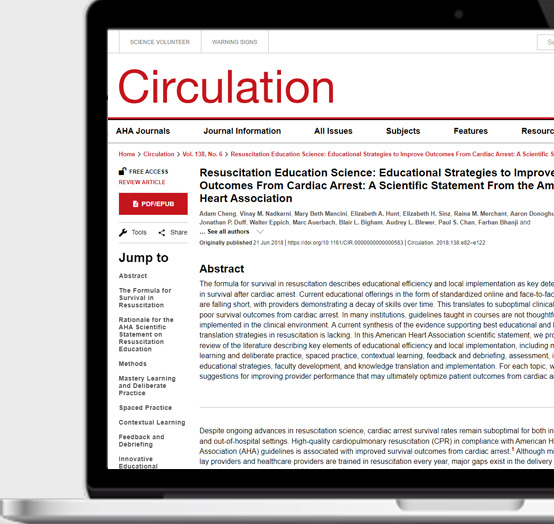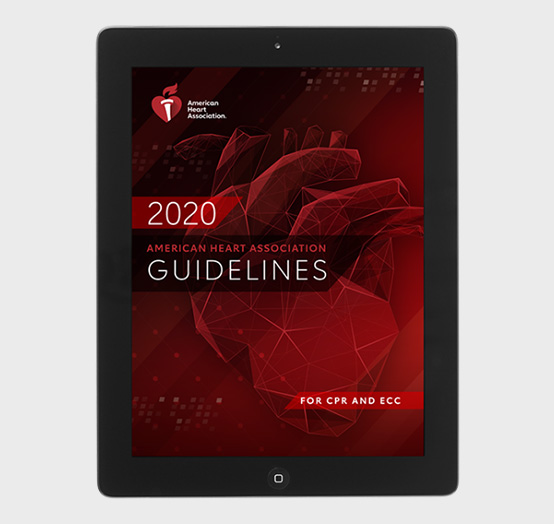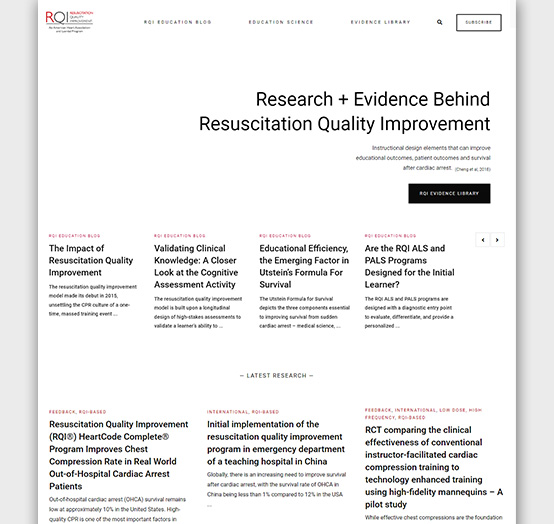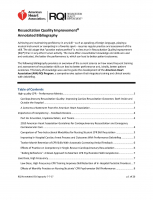Leading Science
The RQI Portfolio incorporates the latest American Heart Association science and Laerdal Medical technology for a learning experience that aims to achieve mastery of resuscitation skills. Learners reach this level of mastery with deliberate practice and the use of the RQI Simulation Station in a low-dose, high-frequency model.
2018 Resuscitation Education Science Statement
In 2018, the AHA recognized the body of research highlighting educational strategies to improve outcomes from cardiac arrest. These key elements of educational efficiency are included in the design of the RQI Portfolio, including deliberate practice, spaced learning, feedback, assessment and contextual learning.

- The current schedule of 1 to 2 days of resuscitation training every couple of years is effective for short-term learning. However, learners often do not retain these skills in the long term. Shorter learning sessions every few months may improve learning outcomes.

2020 AHA Guidelines
The AHA releases guidelines for CPR and emergency cardiovascular care (ECC) every five years. These guidelines reflect the latest global science related to medical and education recommendations for resuscitation. These guidelines are informed by the 2020 International Consensus on CPR and ECC with Treatment Recommendations (CoSTR). Current RQI Programs adhere to the most recent 2020 AHA guidelines and will continuously update to reflect the latest guidance.
The AHA Guidelines are considered the gold standard of clinical recommendations in the practice of resuscitation science in North America and around the world.
- Use of a deliberate practice and mastery learning model during resuscitation training improves skill acquisition and retention for many critical tasks.
- Implementation of a spaced learning approach for resuscitation training improves clinical performance and technical skills compared with massed learning.
- The use of CPR feedback devices during resuscitation training promotes CPR skill acquisition and retention.
Evidence Library on LearningRQI
Anyone can access the library of literature demonstrating the science behind and impact of the RQI Program. This link also provides additional resources for how the RQI Program is designed and measured via science and evidence.

- Beginning the pilot, at baseline, only 1 in 5 (21%) healthcare providers were able to pass a blinded cardiac compression assessment.
- Participants that practiced their compression skills on the RQI training system achieved significantly higher reassessment scores than those that did not.
Source: Pighills, A. et al. Journal of Nursing Education and Practice. 2021
Designing for Quality Improvement
-
- Performance of infant compressions at the simulation station increased from 91.5% in Q1 to 95% in Q5 and infant ventilations from 82.9% in Q1 to 95.5% in Q5
- Performance of adult/child compressions at the simulation station increased from 84.3% in Q1 to 96.2% in Q5, and adult/child ventilations from 79.8% in Q1 to 95.3% in Q5
- Using quarterly, brief CPR training at a skills station, hospital BLS providers who failed to meet CPR performance measures during the first quarter quickly improved on the skills necessary to meet CPR measures with the RQI simulation station.
- Nursing students who refreshed with 3-month or personalized prescribed intervals had overall higher compression scores compared with those who refreshed at 6-month intervals.
- Post a traditional BLS course, only 59% of nursing students demonstrated correct compression depth and 42% demonstrated correct compression rate. Overall compression scores increased by 81% post one RQI training session.
- Overall ventilation scores with the use of a bag-mask device increased by 273% (19% to 70%) after one RQI training session.
- Improved chest compression fraction during in-hospital cardiac arrest events from pre-RQI of 83% to post-RQI of 93%.
- Over half of participants (67.4%) agreed or strongly agreed that RQI was their preferred method of BLS training versus the traditional 2-year model.
- 81.8% of participants provided feedback on what they like about the RQI program, including ands-on practice, real-time feedback, repetition and self-directed learning.
Initial implementation of the resuscitation quality improvement program in emergency department of a teaching hospital in China »
Post the RQI training, both novice and experienced provider groups achieved qualified CPR performance (score of 75% or more) for compressions and ventilation, per American Heart Association guidelines.





